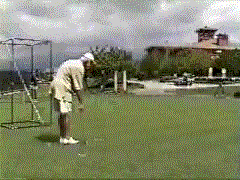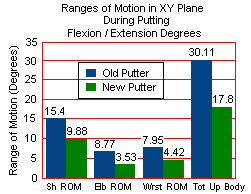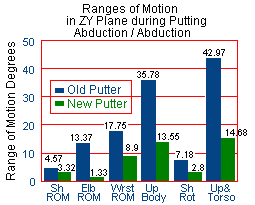Results |
|

|
The following findings were determined for the kinematics of the putting techniques utilized when putting with a traditional and experimental putter prototype. |
|
Subjects
Four males and 2 females served as putting subjects for this study. The males’ mean weight was 73.0 + 2.9 lbs and mean height was 173.0 + 19.1 inches, while the female golfers’ mean weight was 67.5 + 2.1 lbs and their mean height was 131.5 + 33.2 inches. Putting Joint Actions Intersegmental joint angles were determined for the shoulder, elbow, and wrist at the end of the back swing at contact. The joint angle difference between these two positions represented the joint ROM along the xy plane (z axis) or zy plane (x axis). Motion along XY Plane (Z axis)  The traditional putting technique exhibited 15.4 degrees of flexion along the xy plane at the shoulder joint, 6.8 and 7.95 degrees of movement at the elbow and wrist joints, respectively. The summed ROMs resulted in 30.1 degrees of motion (flexion / extension of the upper body (See Table 1 & Figure 2). The new putter design afforded 9.9, 3.5, and 4.4 degrees of motion (flexion / extension) along the xy plane at the shoulder, elbow, and wrist joint, respectively.
The traditional putting technique exhibited 15.4 degrees of flexion along the xy plane at the shoulder joint, 6.8 and 7.95 degrees of movement at the elbow and wrist joints, respectively. The summed ROMs resulted in 30.1 degrees of motion (flexion / extension of the upper body (See Table 1 & Figure 2). The new putter design afforded 9.9, 3.5, and 4.4 degrees of motion (flexion / extension) along the xy plane at the shoulder, elbow, and wrist joint, respectively.
Statistical analysis using a related t test found the wrist and total upper body motion to be statistically different at the .10 level of significance (See Table 2). The new putter design utilized 59% of the putting motion required by a traditional putting technique (See Figure 3). This smaller ROM required to complete the forward / backward movement would indicate that the new putter design produced a more efficient putting stroke to push the ball while reducing the joint ROM variability and likelihood for error. Motion along ZY Plane (X axis) The traditional putting technique utilized 4.7, 13.4, and 17.8 degrees of motion along the zy plane for the shoulder, elbow, and wrist joints. In contrast, the experimental putter required 3.3, 1.3, and 8.9 degrees of motion at the shoulder, elbow and wrist (See Table 3 & Figure 4).  Statistical analysis found only the elbow to demonstrate a significantly different
joint action (p=.017) when comparing the two putting techniques (See Table 4). The putting technique using the experimental putter required only 9.9% of the elbow ROM that was used by the traditional putter. This reduction in motion was due to the elbow being placed while extended behind the club shaft hanging alongside the trunk in the new putting technique and during the traditional technique the elbows are partially flexed or extended while forming a putting triangle between the shoulders, upper arms, and forearms. The triangle is pitched away from the torso in order to provide the necessary swing clearance. Since the new putting technique requires about 1 degree of motion at the elbow joint to putt while the traditional movement requires 13.4 degrees, there is a significant reduction in the potential variability or error (See Table 5).
Statistical analysis found only the elbow to demonstrate a significantly different
joint action (p=.017) when comparing the two putting techniques (See Table 4). The putting technique using the experimental putter required only 9.9% of the elbow ROM that was used by the traditional putter. This reduction in motion was due to the elbow being placed while extended behind the club shaft hanging alongside the trunk in the new putting technique and during the traditional technique the elbows are partially flexed or extended while forming a putting triangle between the shoulders, upper arms, and forearms. The triangle is pitched away from the torso in order to provide the necessary swing clearance. Since the new putting technique requires about 1 degree of motion at the elbow joint to putt while the traditional movement requires 13.4 degrees, there is a significant reduction in the potential variability or error (See Table 5).
The upper body combined motion in the zy plane (x axis) represented by the sum of the shoulder, elbow, and wrist joint ROMs were 35.8 degrees for the traditional and 13.6 degrees for the new putting technique. Again, a significant (p=.035) reduction in the upper body motion occurred while using the experimental putter to accomplish the same putt. The new putting technique required only about 38% of the joint motion employed with a traditional putting style (See Figure 4). |
